
Total Hip Replacement Exercise Guide
Regular exercises to restore your normal hip motion and strength and a gradual return to everyday activities are important for your full recovery. Your orthopaedic surgeon and physical therapist may recommend that you exercise 20 to 30 minutes 2 or 3 times a day during your early recovery. They may suggest some of the following exercises.
Early Postoperative ExercisesThese exercises are important for increasing circulation to your legs and feet to prevent blood clots. They also are important to strengthen muscles and to improve your hip movement. You may begin these exercises in the recovery room shortly after surgery. It may feel uncomfortable at first, but these exercises will speed your recovery and reduce your postoperative pain. These exercises should be done as you lie on your back with your legs spread slightly apart.
Ankle PumpsSlowly push your foot up and down. Do this exercise several times as often as every 5 or 10 minutes. This exercise can begin immediately after surgery and continue until you are fully recovered.
 Ankle Rotations
Ankle Rotations
 Move your ankle inward toward your other foot and then outward away from your other foot.
Move your ankle inward toward your other foot and then outward away from your other foot.
Repeat 5 times in each direction 3 or 4 times a day.
Bed-Supported Knee Bends Slide your heel toward your buttocks, bending your knee and keeping your heel on the bed. Do not let your knee roll inward.
Slide your heel toward your buttocks, bending your knee and keeping your heel on the bed. Do not let your knee roll inward.
Repeat 10 times 3 or 4 times a day
Buttock Contractions Tighten buttock muscles and hold to a count of 5.
Tighten buttock muscles and hold to a count of 5.
Repeat 10 times 3 or 4 times a day
Abduction Exercise Slide your leg out to the side as far as you can and then back.
Slide your leg out to the side as far as you can and then back.
Repeat 10 times 3 or 4 times a day
Quadriceps Set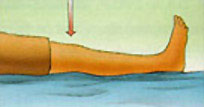 Tighten your thigh muscle. Try to straighten your knee. Hold for 5 to 10 seconds.
Tighten your thigh muscle. Try to straighten your knee. Hold for 5 to 10 seconds.
Repeat this exercise 10 times during a 10-minute period.
Continue until your thigh feels fatigued.
Straight Leg Raises Tighten your thigh muscle with your knee fully straightened on the bed. As your thigh muscle tightens, lift your leg several inches off the bed. Hold for 5 to 10 seconds. Slowly lower.
Tighten your thigh muscle with your knee fully straightened on the bed. As your thigh muscle tightens, lift your leg several inches off the bed. Hold for 5 to 10 seconds. Slowly lower.
Repeat until your thigh feels fatigued.
Standing ExercisesSoon after your surgery, you will be out of bed and able to stand. You will require help since you may become dizzy the first several times you stand. As you regain your strength, you will be able to stand independently. While doing these standing exercises, make sure you are holding on to a firm surface such as a bar attached to your bed or a wall.
Standing Knee Raises
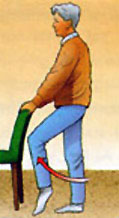 Lift your operated leg toward your chest. Do not lift your knee higher than your waist. Hold for 2 or 3 counts and put your leg down.
Lift your operated leg toward your chest. Do not lift your knee higher than your waist. Hold for 2 or 3 counts and put your leg down.
Repeat 10 times 3 or 4 times a day Top of page |
Standing Hip Abduction
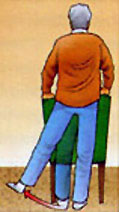 Be sure your hip, knee and foot are pointing straight forward. Keep your body straight. With your knee straight, lift your leg out to the side. Slowly lower your leg so your foot is back on the floor.
Be sure your hip, knee and foot are pointing straight forward. Keep your body straight. With your knee straight, lift your leg out to the side. Slowly lower your leg so your foot is back on the floor.
Repeat 10 times 3 or 4 times a day Top of page |
Standing Hip Extensions
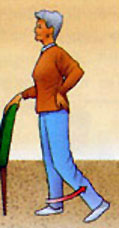 Lift your operated leg backward slowly. Try to keep your back straight. Hold for 2 or 3 counts. Return your foot to the floor.
Lift your operated leg backward slowly. Try to keep your back straight. Hold for 2 or 3 counts. Return your foot to the floor.
Repeat 10 times 3 or 4 times a day Top of page |
Soon after surgery, you will begin to walk short distances in your hospital room and perform light everyday activities. This early activity helps your recovery by helping your hip muscles regain strength and movement.
Walking with Walker, Full WeightbearingStand comfortably and erect with your weight evenly balanced on your walker or crutches. Move your walker or crutches forward a short distance. Then move forward, lifting your operated leg so that the heel of your foot will touch the floor first. As you move, your knee and ankle will bend and your entire foot will rest evenly on the floor. As you complete the step allow your toe to lift off the floor. Move the walker again and your knee and hip will again reach forward for your next step. Remember, touch your heel first, then flatten your foot, then lift your toes off the floor. Try to walk as smoothly as you can. Don't hurry. As your muscle strength and endurance improve, you may spend more time walking. Gradually, you will put more and more weight on your leg.
Walking with Cane or CrutchA walker is often used for the first several weeks to help your balance and to avoid falls. A cane or a crutch is then used for several more weeks until your full strength and balance skills have returned. Use the cane or crutch in the hand opposite the operated hip. You are ready to use a cane or single crutch when you can stand and balance without your walker, when your weight is placed fully on both feet, and when you are no longer leaning on your hands while using your walker.
Stair Climbing and Descending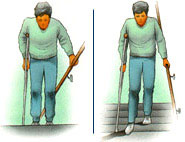 The ability to go up and down stairs requires both flexibility and strength. At first, you will need a handrail for support and you will only be able to go one step at a time. Always lead up the stairs with your good leg and down the stairs with your operated leg. Remember "up with the good" and "down with the bad." You may want to have someone help you until you have regained most of your strength and mobility. Stair climbing is an excellent strengthening and endurance activity. Do not try to climb steps higher than those of the standard height of seven inches and always use the handrail for balance.
Advanced Exercises and Activities
The ability to go up and down stairs requires both flexibility and strength. At first, you will need a handrail for support and you will only be able to go one step at a time. Always lead up the stairs with your good leg and down the stairs with your operated leg. Remember "up with the good" and "down with the bad." You may want to have someone help you until you have regained most of your strength and mobility. Stair climbing is an excellent strengthening and endurance activity. Do not try to climb steps higher than those of the standard height of seven inches and always use the handrail for balance.
Advanced Exercises and Activities
A full recovery will take many months. The pain from your problem hip before your surgery and the pain and swelling after surgery have weakened your hip muscles. The following exercises and activities will help your hip muscles recover fully.
These exercises should be done in 10 repetitions four times a day with one end of the tubing around the ankle of your operated leg and the opposite end of the tubing attached to a stationary object such as a locked door or heavy furniture. Hold on to a chair or bar for balance.
Elastic Tube Exercises
Resistive Hip Flexion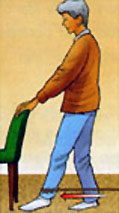 Stand with your feet slightly apart. Bring your operated leg forward keeping the knee straight. Allow your leg to return to its previous position.
Stand with your feet slightly apart. Bring your operated leg forward keeping the knee straight. Allow your leg to return to its previous position. |
Resistive Hip Abduction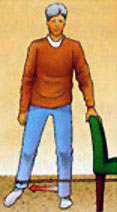 Stand sideways from the door and extend your operated leg out to the side. Allow your leg to return to its previous position.
Stand sideways from the door and extend your operated leg out to the side. Allow your leg to return to its previous position. |
Resistive Hip Extensions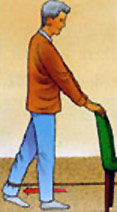 Face the door or heavy object to which the tubing is attached and pull your leg straight back. Allow your leg to return to its previous position.
Face the door or heavy object to which the tubing is attached and pull your leg straight back. Allow your leg to return to its previous position. |
Exercycling is an excellent activity to help you regain muscle strength and hip mobility. Adjust the seat height so that the bottom of your foot just touches the pedal with your knee almost straight. Pedal backwards at first. Pedal forward only after comfortable cycling motion is possible backwards. As you become stronger (at about 4 to 6 weeks) slowly increase the tension on the exercycle. Exercycle forward 10 to 15 minutes twice a day, gradually building up to 20 to 30 minutes 3 to 4 times a week.
WalkingTake a cane with you until you have regained your balance skills. In the beginning, walk 5 or 10 minutes 3 or 4 times a day. As your strength and endurance improves, you can walk for 20 or 30 minutes 2 or 3 times a day. Once you have fully recovered, regular walks, 20 or 30 minutes 3 or 4 times a week, will help maintain your strength.
Source: http://orthoinfo.aaos.org/topic.cfm?topic=A00303
